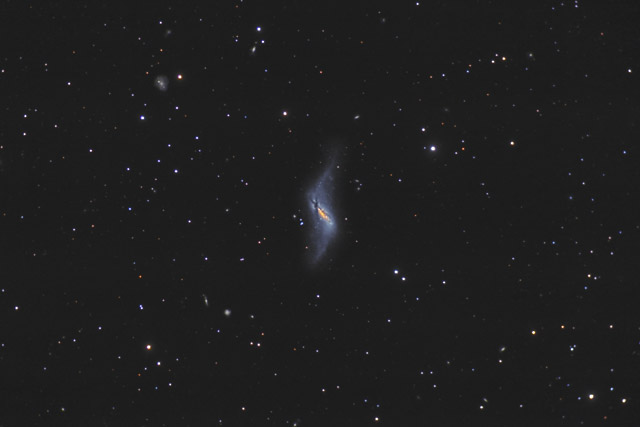NGC 660 - A Polar Ring Galaxy in Pisces
|

|
NGC 660 is an uncommon type of galaxy called a Polar Ring Galaxy. In a polar ring galaxy, there are one or more rings of stars, gas, and dust that orbit the galaxy nearly perpendicular to the main disk. Astronomers hypothesize that this type of galaxy is formed from a near collision of two galaxies. While the galaxies are interacting the polar ring galaxy strips some gas and dust from the other galaxy and this newly acquired matter begins orbiting in the perpendicular plane.
Be sure to click on the image to see the high resolution version, as there are numerours background galaxies scattered throughout the photo.
In this image, North is up, This image is cropped to 76% of the original full frame.
| Exposure Details |
| Lens |
Celestron C-8 SCT with Celestron focal reducer |
| Focal Length |
1160mm (measured from the image) |
| Focal Ratio |
f/5.8 |
| |
| Mount |
Schaefer GEM - 7 1/2 Byers gear |
| Guiding |
ONAG On-Axis Guider, Lodestar autoguider, PHD Guiding |
| |
| Camera |
Canon 450D - Gary Honis modified |
| Exposure |
337 subexposures of 180 seconds each at ISO 1600 - about 16 3/4 hours total |
| Calibration |
30 darks, 30 flats, 30 bias |
| |
| Date |
August 14, 15, 16, 18, and 19, 2012 |
| Temperature |
69F on 8/14, 66F-8/15, 69F-8/16, 64F-8/18, 66F-8/19 |
| SQM Reading |
21.4 (Bortle 4) on 8/14 thru 8/18, 21.5 (Bortle 4) on 8/19 |
| Seeing |
4/5 on 8/14 and 8/15, 5/5 on 8/16, 8/18, and 8/19 |
| Location |
Pine Mountain Club, California |
| |
| Software Used |
Images Plus 4.5 for camera control, calibration, stacking, digital development, adaptive Richardson-Lucy deconvolution, multiresolution sharpening, smoothing and noise reduction. Registar used for stack alignment. Photoshop CS5 used for levels and curves, color correction, selective color, match color, high pass filter, star shrinking, lab color, saturation adjustments, screen mask invert, hdr toning, and smart sharpen. Gradient Xterminator for gradient removal. Carboni Tools for additional saturation adjustments, noise reduction, and smoothing. HLVG for additional color correction. |
| Notes |
This galaxy is a fascinating target. I enjoyed excellent seeing on all of the nights I photographed this object. However, I had several nights where I had some high clouds. As such, the large amount of exposure time I had on this object didn't pay off as well as it could have. Nonetheless, I captured a decent amount of the faint halo, and the image enjoys fairly good detail. |
|
|